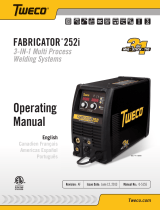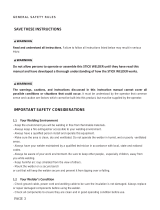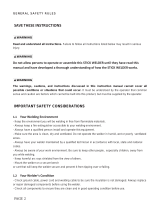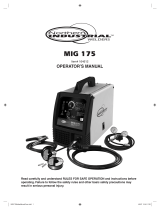
SAFETY INSTRUCTIONS FABRICATOR 252i
Manual 0-5155 1-5 SAFETY INSTRUCTIONS AND WARNINGS
ABOUT PACEMAKERS:
The above procedures are among those also
normally recommended for pacemaker wearers.
Consult your doctor for complete information.
1.02 General Safety Information for
Victor CS Regulator
A. Fire Prevention
Welding and cutting operations use fire or combustion
as a basic tool. The process is very useful when properly
controlled. However, it can be extremely destructive if not
performed cor rectly in the proper environment.
1. The work area must have a fireproof floor.
2. Work benches or tables used during welding or cut-
ting operations must have fireproof tops.
3. Use heat resistant shields or other approved material
to protect nearby walls or unprotected flooring from
sparks and hot metal.
4. Keep an approved fire extinguisher of the proper
size and type in the work area. Inspect it regularly
to ensure that it is in proper working order. Know
how to use the fire extin guisher.
5. Move combustible materials away from the work
site. If you can not move them, protect them with
fireproof covers.
WARNING
NEVER perform welding, heating, or cutting
operations on a container that has held toxic,
combustible or flammable liq uids, or vapors.
NEVER perform welding, heating, or cutting
operations in an area containing combustible
vapors, flam mable liquids, or explosive dust.
B. Housekeeping
WARNING
NEVER
allow oxygen to contact grease, oil, or
other flam mable substances. Although oxygen
by itself will not burn, these substances become
highly explosive. They can ignite and burn vio-
lently in the presence of oxygen.
Keep ALL apparatus clean and free of grease, oil and other
flammable substances.
C. Ventilation
WARNING
Ade quately ventilate welding, heating, and cut-
ting work areas to prevent accumulation of ex-
plosive or toxic concen trations of gases. Certain
combinations of metals, coatings, and gases
generate toxic fumes. Use respiratory protection
equipment in these circumstances. When weld-
ing/brazing, read and understand the Material
Safety Data Sheet for the welding/brazing alloy.
D. Personal Protection
Gas flames produce infrared radiation which may have a
harm ful effect on the skin and especially on the eyes. Select
goggles or a mask with tempered lenses, shaded 4 or darker,
to protect your eyes from injury and provide good visibility
of the work.
Always wear protective gloves and flame-resistant clothing to
protect skin and clothing from sparks and slag. Keep collars,
sleeves, and pockets buttoned. DO NOT roll up sleeves or cuff
pants.
When working in a non-welding or cutting environment,
always wear suitable eye protection or face shield.
WARNING
Practice the following safety and operation pre-
cautions EVERY TIME you use pressure regula-
tion equipment. Deviation from the following
safety and operation instructions can result in
fire, explosion, damage to equipment, or injury
to the operator.
E. Compressed Gas Cylinders
The Department of Transportation (DOT) approves the design
and manufacture of cylinders that contain gases used for
welding or cutting operations.
1. Place the cylinder (Figure 1-1) where you will use
it. Keep the cylinder in a vertical position. Secure it to a
cart, wall, work bench, post, etc.
























